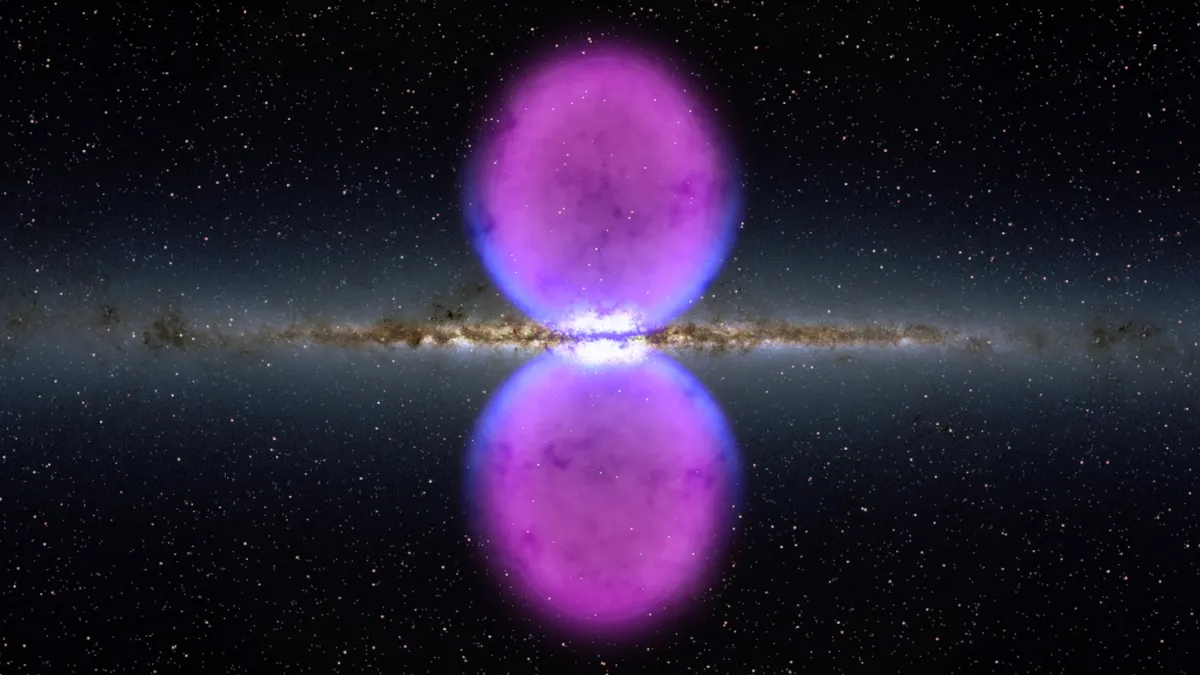
Two of the strangest structures in the galaxy, known as the Fermi bubbles, have just become even more intriguing. These colossal formations, resembling a massive hourglass, extend above and below the center of the Milky Way. For millions of years, these enormous twin orbs of superheated plasma have been venting from the galactic center, now spanning approximately 50,000 light-years from end to end. Remarkably, this makes them half as tall as the Milky Way itself.
Recent research conducted using the U.S. National Science Foundation's Green Bank Telescope in West Virginia has unveiled a surprising revelation: nestled deep within these superheated bubbles are gigantic clouds of cold hydrogen gas. This gas has somehow managed to endure in an environment of extreme heat. The researchers suggest that these enigmatic clouds are likely remnants of much larger structures that were expelled from the galaxy's center millions of years ago.
Lead study author Rongmon Bordoloi, an associate professor in the Department of Physics at North Carolina State University, explained this phenomenon with an analogy: “Think of it like dropping an ice cube into boiling water. A small one melts quickly, but a larger one lasts longer.” Bordoloi further stated that these clouds may be remnants of even larger structures that are currently being eroded by the galactic wind.
This discovery suggests that the central black hole of our galaxy may have experienced a significant outburst of matter more recently than scientists had previously believed. The findings were published in The Astrophysical Journal Letters on July 7.
The Fermi bubbles were first identified in 2010 by NASA's Fermi Gamma-ray Space Telescope. Although they are comparable in size to our galaxy, they are only detectable in gamma-rays. They also overlap with an equally mysterious X-ray counterpart known as the eROSITA bubbles. The plasma that constitutes the Fermi bubbles reaches temperatures exceeding one million kelvins (nearly two million degrees Fahrenheit), which suggests that they are remnants of a violent outburst from the Milky Way's central black hole. This cataclysmic event likely ejected twin jets of matter above and below the galactic plane, scooping up nearby material and flinging it into the cosmos.
The cold hydrogen clouds identified in this study vary in size, ranging from approximately 13 to 91 light-years across, making each cloud significantly larger than our solar system. For these cold clouds to have survived in the extreme environment of the Fermi bubbles—located about 13,000 light-years above the center of the galaxy—they must have originally been much larger when they were swept into the bubble's grasp. Bordoloi emphasized that, in principle, these clouds shouldn’t have been able to endure for such a long time, yet their existence provides a crucial temporal marker.
The survival of these cold hydrogen clouds indicates that the Milky Way's central black hole may have erupted just a few million years ago—a mere blink of an eye in cosmic terms. This finding could help solve a significant mystery regarding the age of the Fermi bubbles, suggesting that our galaxy's central black hole experiences sporadic, violent outbursts whenever substantial amounts of material fall into it.
While the exact timeline of black hole eruptions in our galaxy remains uncertain, the evidence points to the fact that features like the Fermi Bubbles—and, more recently, the eROSITA Bubbles—indicate a much more active center of the Milky Way than previously understood. Bordoloi concluded that these discoveries open up new avenues for understanding the dynamics of our galaxy.